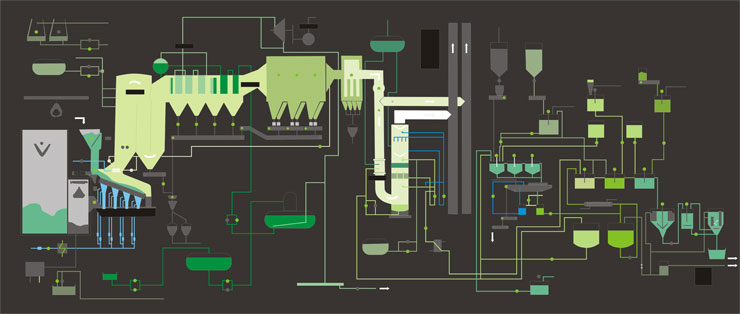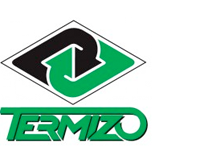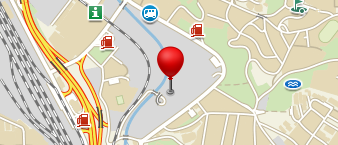Technical description
The incinerator of community waste, runned by the company TERMIZO a.s. is situated in the grounds of the heating plant in Liberec. The incinerator plant is therefore joined with the heating plant network junction, which allows the usage of the synergistic effect during the intake of auxiliary energy and operation resources; this enables to use synergistic effect during distribution of produced energy into the central supply of heat.
Talking about a piece of modern equipment made for energetic usage which is built on the following principles:
- Pre-sorted municipal waste is rationed into the process of energetically use after arrival to our terminal without other corrections (with an exception of larger waste eg. furniture and others).
- The incinerator uses one technological line with a capacity of 12t of waste per hour and produces energy from municipal and company waste which has the same quality. Its hourly production is 2.5 MW of electrical energy and 23.0 MW of heating energy. On one shift there are four employees working (including one crane operator). The company Termizo employees overall forty workers.
- Electrical and heating energy are produced simultaneously.
- Harmful substances which are released from the process of usage of energetic waste are abolished, therefore processed in a way that they will not affect the present or future generation.
- The installed process of burned gases cleaning enables compliance with the emission limits given by the law of EU (2000/76/EC) with an obvious reserve.
- The cleaning of burned gases is done so that the updated recommendations of waste burning in the EU are respected. The technical solution was realized in the following two stages.
- The separation of solid particle emission, inorganic acids, sulfur oxides, N-oxides, and heavy metals from waste gases (realized in the year 1999).
- The separation of organic waste gases components, the PCDD/F type (dioxines) – implementation started in the year 2001. First of all the capture technology of burned gases by powdered active carbon was installed, and from September 2003 new technology based on catalytic decomposition on special textile filters was introduced.
- The architectonic planning of the whole incineration plant was emphasized on. Because of plant’s close vicinity to the center of the city, attention was paid to its architectural form.
Basic technological scheme of the incineration plant

-
The Waste bunker

The bunker serves as a technical provisional storage for fuel before its energetic usage. Capacity of the bunker is 3000 m3 imported mixed waste.
-
The Burning of waste

In the central fire alone the temperature reaches 950 – 1100°C, during which the thermo-oxidizing destruction of waste into single components occurs. Clinker, which falls out from a grate at the end of the line into a water bath, is then continuously exported into the clinker bunker. Clinker contains a maximum of 3 % by weight of organic carbon and is certified as a product that is used for reclamation and building usage.


During the yearly production there are two to three planed breaks which last approximately one month all-round. A whole productive year sums up to 8000 h/ per year.
-
The usage of heat
Energy released during the burning of waste is in the form of heat withdrawn from combusted gases and transferred to steam. Produced superheated steam is put through a back-pressured turbine and added into the heating system, in which it enables simultaneous production of electrical (2,5 MW) and heated (23 MW) energy. Respective use of electrical energy during production is approx 1 MW and is covered with its own produced energy.

-
The cleaning of waste gases
Waste gases, which go through the boiler system, lose heat that is used to manufacture steam for the pressure turbine. This system also feeds long distance heating. Light ashes which are caught in the boiler are periodically knocked down and drained into ash silo. Waste gases contain harmful substances that are removed in a multistage scrubber by process of physico-chemical absorption.
Generally is accepted that incineration plant which meets the regulation 2000/76/EC according to the European Parliament and EU Council put forward on the date 4. 12. 2000 does not have any negative influence on the environment.
Termizo a.s. was designed in conformity with this regulation and meets emission limits with a distinct reserve.
4.1. Reduction of N-oxides
N-oxides are reduced with a spray application of ammonia water (NH4OH) into a flux of waste gases in the second current of the boiler.
4.2. Seperation of ash
Tiny particles of ash are separated in an electro filter.
4.3. The waste gases scrubber
The waste gases scrubber services in the cleaning process of waste gases. The process is based on the wet physico-chemical way, which has three stages.
4.4. Reduction of the PCDD/F content
Reduction of the PCDD/F content happens on a catalytic layer of textile filters GORE. Reached concentration values of contaminants in waste gases are then under the limit 0.1 TEQ with a reserve.
-
Treatment of ash

Some incinerators do not use this cleaning technology and therefore produce unpurified ash, Untreated ash has dangerous properties and must be then handled as dangerous waste. The principle of ash treatment is the washing-out of heavy metals from raw ash into diluted solution of hydrochloric acid. This eliminates all dangerous properties.
-
Purification of waste water
Acid water from the process of waste gases cleaning flows into the water treatment device. After passing the device, the purified water is drained into the town’s sewer system.



